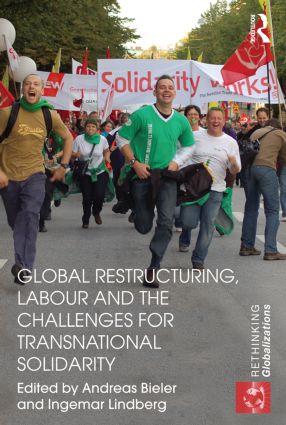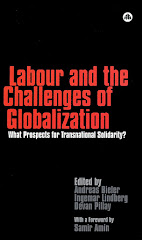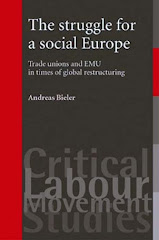The book ‘Grounding Globalization: Labour in the Age of Insecurity’ by Eddie Webster, Rob Lambert and Andries Bezuidenhout is an excellent engagement with labour’s current role in the global economy. It not only outlines well the challenges faced by trade unions in view of neo-liberal globalisation, it also explores new ways of resistance.
Historically, trade unions emerged within states and developed strong positions within the political economies of advanced industrialised countries. Neo-liberal globalisation, characterised by the transnationalisation and fragmentation of production processes and the increasing informalisation of working contracts, has undermined these positions of power (Bieler, Lindberg and Sauerborn, 2010:249-53). And yet, globalisation has not only disempowered trade unions. It has also resulted in new weapons. The book Grounding Globalization: Labour in the Age of Insecurity makes a significant and highly important contribution to understanding the possibilities of resistance to global restructuring along four lines.
First, the book demonstrates, how the restructuring of manufacturing in the white goods sector is played out in three different locales, the Electrolux production site in Orange in Australia, the LG plant in Changwon in South Korea and the Defy establishment in Ezakheni in South Africa. Although the exact nature of restructuring differs due to varied local and national conditions from case study to case study, the general conclusion is clear. ‘In the age of insecurity, the factories in Changwon, Orange and Ezakheni do not only manufacture refrigerators, they actively manufacture insecurity as the key source of discipline over workers’ (P.77). In other words, there is a shift to a new regime of control characterised as market despotism. But the authors do not stop here. The manufacturing of insecurity in times of neo-liberal globalisation is not only the result of restructuring in transnational production structures, it is also further deepened through the privatisation of public services such as water supply and general cut-backs in the public sector. In other words, the authors succeed at making clear that both areas transnational production and public sector restructuring are part and parcel of the same process, the same dynamic allowing capital to continue the reaping of super-profits at the expense of working people.
Second, this analysis of the impact of neo-liberal globalisation and resistance to it is combined with a great sensitivity for the importance of different national and regional conditions as they have emerged over time. Australia, for example, was the first country in the world, which established a system of tripartite industrial relations with the Conciliation and Arbitration Act of 1904. Trade unions were given a prominent place, which allowed them to work tirelessly for the improvement of working conditions and higher salaries of workers. And yet, it was the trade unions, which co-operated closely together with the Australian Labour Party in dismantling the tripartite compromise. ‘When labour came to power in 1983, constructive engagement with the global economy was fully embraced. This carried with it the liberal economic assumptions regarding the role of market forces and the state that had shaped the global change’ (P.176). Unsurprisingly, Australian trade unions were in a very weak position, as soon as a conservative government further deregulated the labour market and with it the tripartite institutions. In South Korea and South Africa, by contrast, the labour movement was shaped in the struggles against authoritarian governments and apartheid respectively. These different histories, in turn, have shaped the way the three labour movements have responded to neo-liberal globalisation.
Third, the book does not stop at outlining general conditions of neo-liberal restructuring. It explores the ‘hidden abode of reproduction’, the concrete impact on the life of families and communities. ‘There is a need to be context and place specific, if one is to understand the impact of globalization on labour and go beyond the workplace to examine the household and the community’ (P.105). It is not enough to focus simply on the implications at the workplace. The pressures of global competition are passed on to workers and through workers onto their families and communities. In the South African case, for example, ‘as competition intensifies in the white goods industry globally, Defy managers are “resolving the crisis of post-apartheid workplace disorder by displacing confrontation, antagonism and disorder into the family, the household and the community. This generates a broader social crisis whose symptoms are the breakdown of social solidarity, intra-household and community conflict, substance abuse, domestic violence, and the proliferation of other crimes”’ (P.117). Unsurprisingly, the response to heightened insecurity is often resignation, as reported from Orange, or individualist responses of working harder, as exemplified by cases in Changwon.
There are, however, also signs of resistance identified in the book. In particular, in addition to Beverly Silver’s focus on market bargaining power, workplace bargaining power, and association power, the authors identify symbolic/moral power and logistical power as new sources of strength for labour. And it is this focus on new power sources as well as concrete forms and possibilities of resistance, which is the book’s fourth major contribution. Symbolic or moral power ‘involves the struggle of “right” against “wrong”, providing the basis for an appeal both to the public and politicians, as well as to allies in civil society’ (P.12). It is part of associational power, ‘since it draws on forms of social organization. But it draws its strength from taking moral claims in the workplace and articulating them as general social claims’ (P.12). Making public the abuse of worker and human rights in shareholder meetings on the basis of having acquired a few shares is an example of what this new power source consists of and what its potential is (P.197). Logistical power, in turn, ‘takes matters out of the workplace and onto the landscape where workplaces are located’ (P.13). In South Korea, for example, ‘the KCTU used a technique of mirror sites, where you set up a website that looks exactly like the one you are targeting, but with messages of protest’ (P.101).
On the basis of this assessment of labour’s power sources, the book then identifies two interesting and novel ways of resistance. In Orange, not everybody had resigned himself/herself to the decline of the local Electrolux production site. On the one hand, workers started to make contact with representatives from Electrolux production sites elsewhere in the world. On the other, they expanded local co-operation with other groups. The latter included local church groups as well as the local apple growers. The latter realised that the pressures they faced due to free trade in agriculture were the same the workers faced in view of the shifting of production to China. It is this kind of wider links, which may prove decisive for successful resistance. The second example is the case of the Southern Initiative on Globalisation and Trade Union Rights (SIGTUR), including South Korean, South African and Australian trade unions amongst others (http://www.sigtur.com; accessed 04/072011). SIGTUR has had a specific Southern dimension from the very beginning of its establishment in 1989/1990 resulting from a joint experience of colonialism, racism and imperialism. This common experience of extreme exploitation has been further deepened by the developments of neo-liberal globalisation. ‘Having never experienced the reformist capitalism of the First Great Transformation there is a sense of continuity between the forced labour regimes of colonialism and the restructuring that they now confront. For this reason Southern workers evidence a more overt and determined resistance to restructuring than Northern workers’ (P.204). Could SIGTUR as a distinctive Southern initiative show labour elsewhere the way forward against exploitation?
Overall, this is clearly a must read for academics and practitioners alike, who are interested in the potential role of labour in the resistance to neo-liberal globalisation. I strongly recommend this book for reading.
Reference
Bieler, Andreas, Ingemar Lindberg and Werner Sauerborn (2010) ‘After thirty years of deadlock:labour’s possible strategies in the new global order’, Globalizations, Vol.7/1-2: 247-60.
Webster, Edward, Rob Lambert and Andries Bezuidenhout (2008) Grounding Globalization: Labour in the Age of Insecurity. Oxford: Blackwell Publishing.
Prof. Andreas Bieler
Professor of Political Economy
University of Nottingham/UK
Andreas.Bieler@nottingham.ac.uk
Personal website: http://www.andreasbieler.net
18 May 2012













No comments:
Post a Comment
Comments welcome!